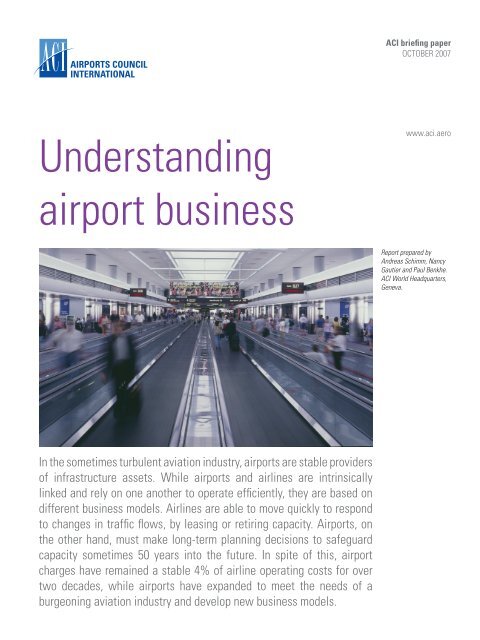Understanding airport business - Airports Council International
Understanding airport business - Airports Council International
Understanding airport business - Airports Council International
You also want an ePaper? Increase the reach of your titles
YUMPU automatically turns print PDFs into web optimized ePapers that Google loves.
ACI briefing paperOCTOBER 2007<strong>Understanding</strong>www.aci.aero<strong>airport</strong> <strong>business</strong>Report prepared byAndreas Schimm, NancyGautier and Paul Benkhe.ACI World Headquarters,Geneva.In the sometimes turbulent aviation industry, <strong>airport</strong>s are stable providersof infrastructure assets. While <strong>airport</strong>s and airlines are intrinsicallylinked and rely on one another to operate efficiently, they are based ondifferent <strong>business</strong> models. Airlines are able to move quickly to respondto changes in traffic flows, by leasing or retiring capacity. <strong>Airports</strong>, onthe other hand, must make long-term planning decisions to safeguardcapacity sometimes 50 years into the future. In spite of this, <strong>airport</strong>charges have remained a stable 4% of airline operating costs for overtwo decades, while <strong>airport</strong>s have expanded to meet the needs of aburgeoning aviation industry and develop new <strong>business</strong> models.
ACI encourages and supports its member <strong>airport</strong>s tocontinuously improve operational and cost efficiency tomoderate the cost of flying and to mitigate intensifyingcapacity shortfalls.Over the past 30 years, <strong>airport</strong>s have evolved from beingsimply municipal infrastructure providers into sophisticatedand <strong>business</strong>-oriented service providers. As in everyindustry the pressure to operate efficiently is constant andarises from customers and stakeholders alike.In recent years <strong>airport</strong>s have played a critical role in keepingair traffic affordable and operating costs for airlines stable,or, as it was the case after September 11, 2001 and SARS,have shown high flexibility in dealing with their airlinescustomers to relieve some of the financial pressure theycame under.Charges on the decreaseFigures collected and analysed by the UN agency<strong>International</strong> Civil Aviation Organisation demonstratethe <strong>airport</strong> industry is healthy and clearly committed toefficiency:• In 2005, the income of 86% of <strong>airport</strong>s worldwidecovers or exceeds their expenses. Only 14% of<strong>airport</strong>s generated a loss.• Expenses on landing and associated <strong>airport</strong> chargesincurred by air carriers have gone up by only 1.4%annually on average between 2000 and 2005.• From 2004 to 2005 total airline expenses incurred on<strong>airport</strong> charges rose by 6% remaining below the 6.6%increase in actual passenger traffic.• In terms of unit costs (cents per available tonne / km)the average annual growth rate of <strong>airport</strong> chargessince 2000 has been only 0.6% while total airlineoperating expenses increased by 1.7% annuallyduring this period. That shows that <strong>airport</strong> chargeshave actually gone down.• Consequently, <strong>airport</strong> charges as share of airlineoperating expenses have constantly decreased overthe past 10 past years to 3.8% in 2005.During the same period the global <strong>airport</strong> industry hasinvested over $US100 billion in its infrastructure andcontinues to plough money into existing and new facilities.ACI estimates that capital expenditure at <strong>airport</strong>s in 2007alone will exceed $US40 billion.Sources of revenueThere are two distinct forms of income and expenditureat an <strong>airport</strong>: ‘aeronautical’ and ‘non-aeronautical’. Inbroad terms, the aeronautical side of the <strong>business</strong> is madeup of the traditional core <strong>airport</strong>-related activities suchas the provision of runways, aircraft stands, facilitationand security areas and the associated personnel to staffsuch activities. The non-aeronautical side accounts for allactivities that are undertaken on top of this core <strong>business</strong>,such as retail, parking, other concessions and rentals. Atmedium and large <strong>airport</strong>s this revenue may account forover 50% of the total income, growing at much faster pacethan aeronautical income or traffic figures and producinggreater profit margins.A key component in enabling <strong>airport</strong>s to generate funds forthe significant investment they must undertake in terminaland airfield expansion is the additional income from nonaeronauticalrevenues. The commercial revenue stream isessential for positive credit ratings and the <strong>airport</strong>’s abilityto attract investors, private or public (and the associatedfinancing of large infrastructure projects). Without thisrevenue, <strong>airport</strong>s would be considered less attractiveinvestments. Many <strong>airport</strong>s would not be able to keepaeronautical charges stable as more income would have tobe generated through aeronautical revenues to cover thehigher cost of raising larger and more expensive credit.There are two broad approaches to the <strong>airport</strong> <strong>business</strong>model. One, the ‘dual till’ system, splits the aeronauticaland non-aeronautical <strong>business</strong> into distinct income andexpenditure accounts. This ensures that income from theaeronautical side of the <strong>business</strong> (such as landing fees,security costs, passenger charges and departure fees) areused for aeronautical expenditure (such as runway repairsand terminal development), leaving the non-aeronauticalincome to provide for non-aeronautical expenditure(building new car parks and expanding retail sections of aterminal) and to make up company profits.By contrast, a ‘single till’ approach (whereby all revenuesof an <strong>airport</strong> would be directly considered for setting<strong>airport</strong> charges) is not advocated by ACI. Including nonaeronauticalrevenues in the cost base for <strong>airport</strong> chargesremoves the incentive for <strong>airport</strong>s to run commercialactivities as it would simply result in lower <strong>airport</strong> incomeon the aeronautical side without increasing overallrevenue. An important source of value creation would bethus squandered. It also provides an unjustified subsidy forthe aeronautical activities that feeds directly into a subsidyfor the airlines flying to an <strong>airport</strong>.User charges
Projection of total world passenger traffic10,0006%8,0005%Annual passengers (millions)6,0004,0002,0004%4%2%1%Annual growth rates02005 2006 2007 2008 2009 2010 2015 20250%
= Major <strong>airport</strong>East Asia example:••Three major hub zonesMany competitors in each zone
Airport employment by regionRegion Employed directly by <strong>airport</strong> operators Total employees on <strong>airport</strong> sitesAfrica-Middle East 50,000 250,000Asia-Pacific 100,000 950,000Europe 156,000 1,100,000Latin America-Caribbean 25,000 200,000North America 43,000 2,000,000Total 374,000 4,500,000User chargesYearAirport charges as a percentage ofairline operating costs1978 4.0%1989 3.7%1998 4.4%1999 4.4%2000 4.2%2001 4.0%2002 4.0%2003 4.0%2004 4.0%2005 3.8%
















